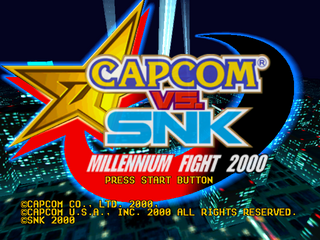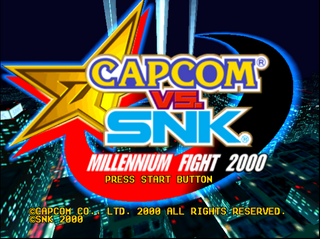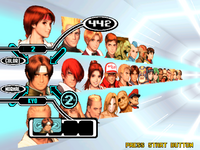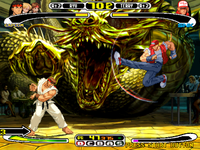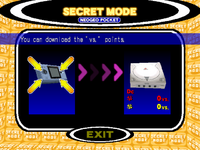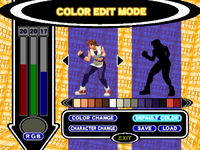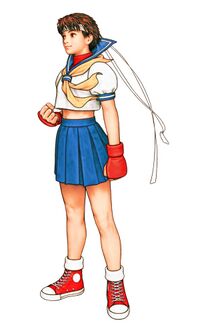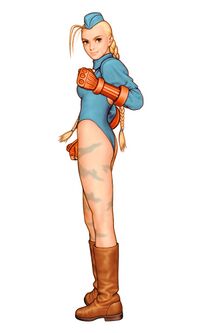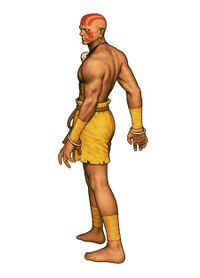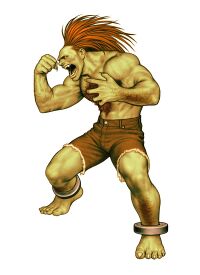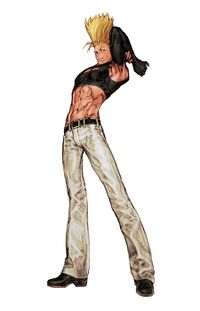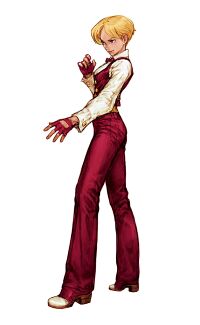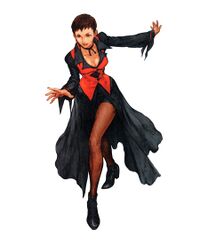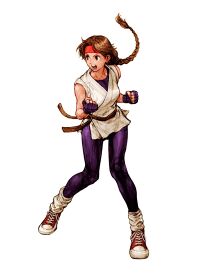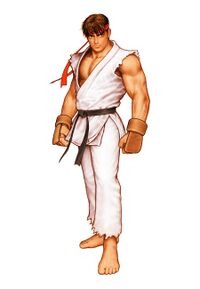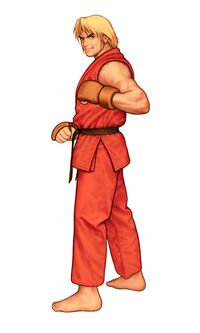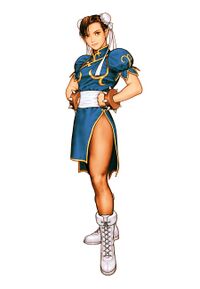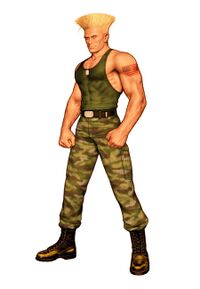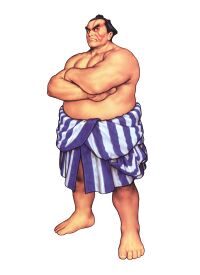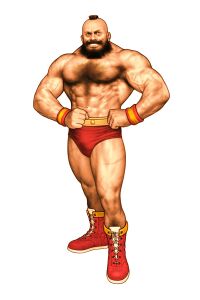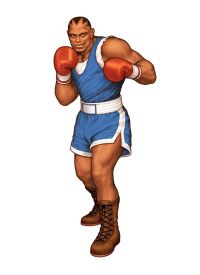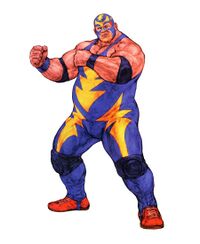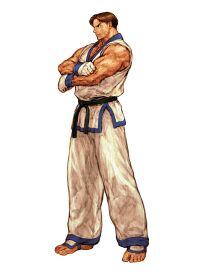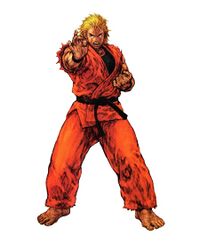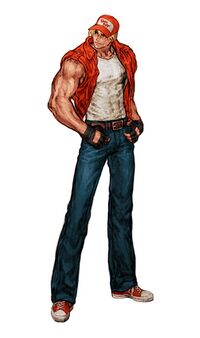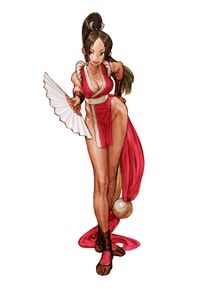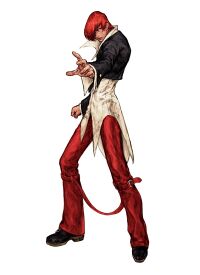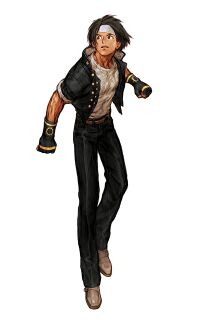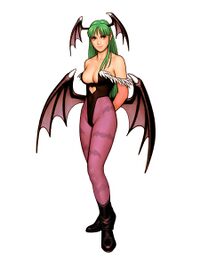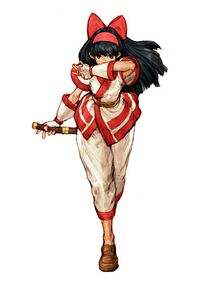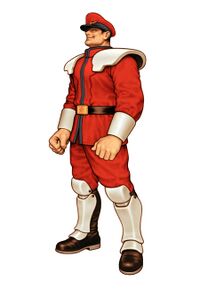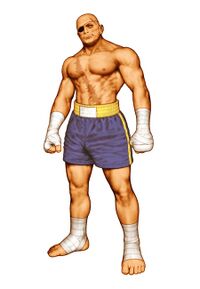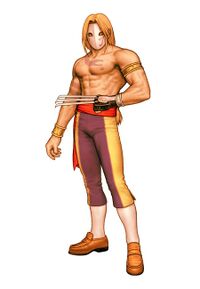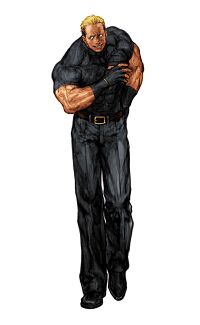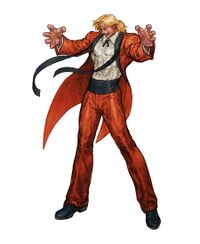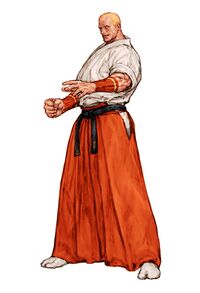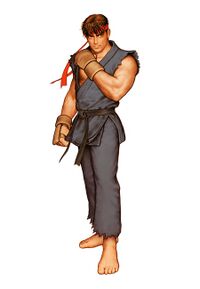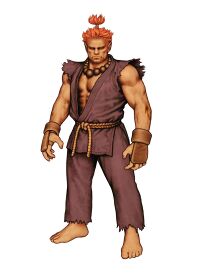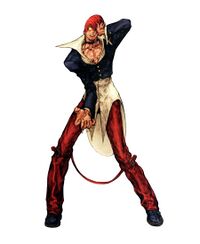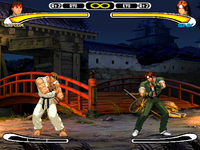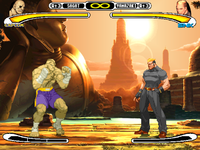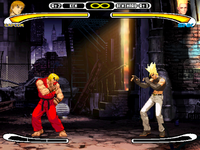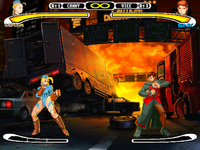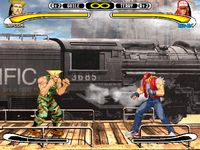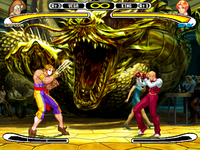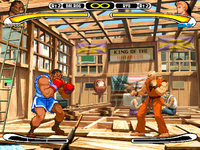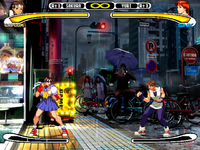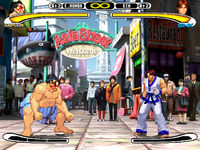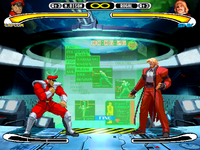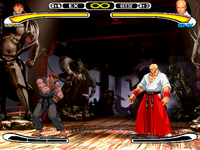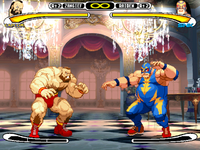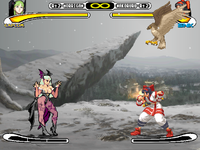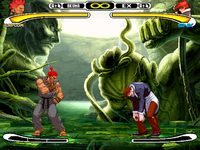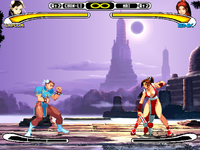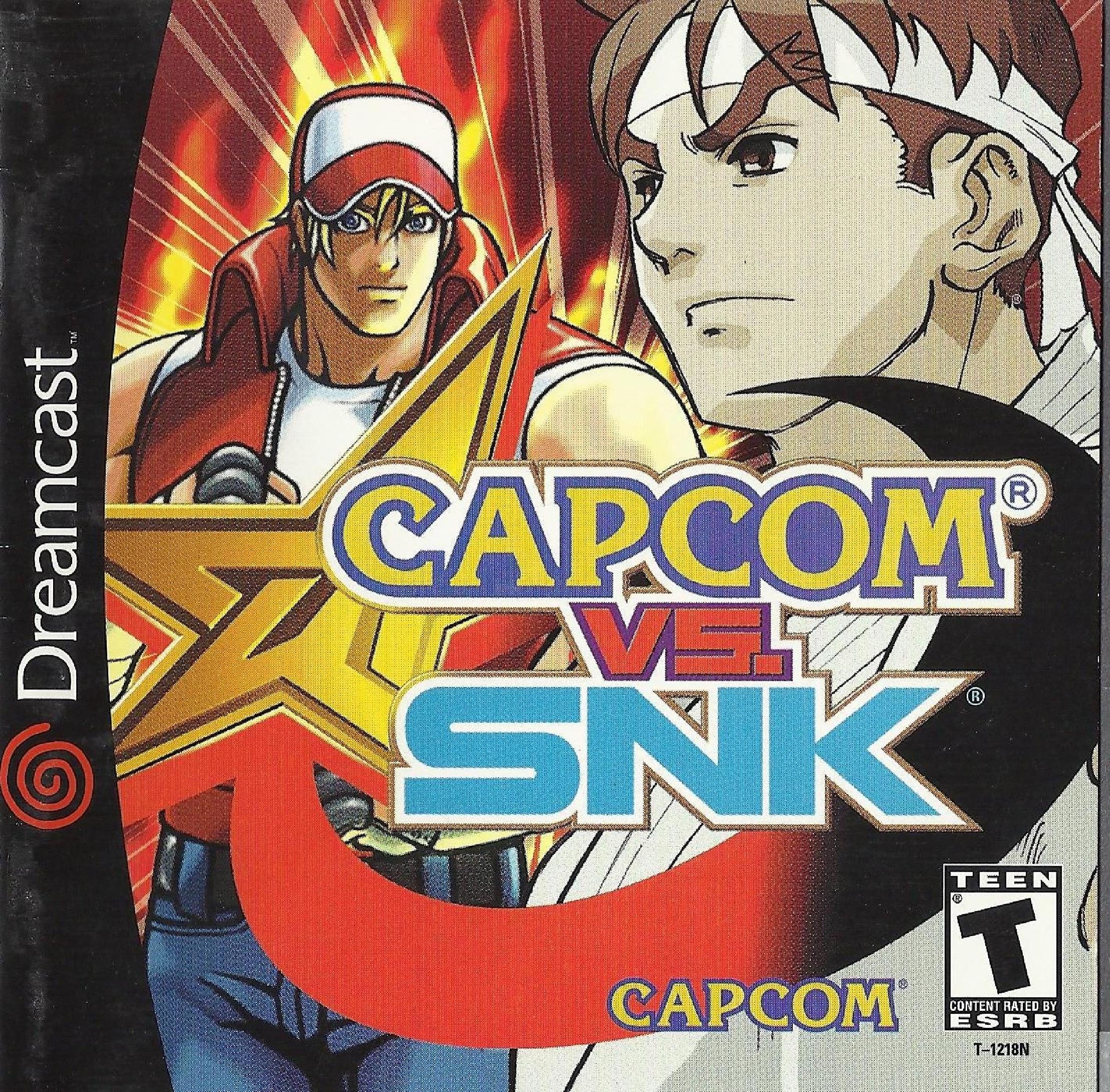Capcom vs. SNK: Millennium Fight 2000
From Sega Retro
| Capcom vs. SNK: Millennium Fight 2000 | |||||||||||||||||||||||||||||||||||||||||||||||||||||
|---|---|---|---|---|---|---|---|---|---|---|---|---|---|---|---|---|---|---|---|---|---|---|---|---|---|---|---|---|---|---|---|---|---|---|---|---|---|---|---|---|---|---|---|---|---|---|---|---|---|---|---|---|---|
| System(s): Sega NAOMI, Sega Dreamcast | |||||||||||||||||||||||||||||||||||||||||||||||||||||
| Publisher: Capcom (JP) Capcom Entertainment (US) Virgin Interactive Entertainment (Europe) | |||||||||||||||||||||||||||||||||||||||||||||||||||||
| Developer: Capcom | |||||||||||||||||||||||||||||||||||||||||||||||||||||
| Licensor: SNK Capcom (US, EU) Capcom USA (US) | |||||||||||||||||||||||||||||||||||||||||||||||||||||
| Peripherals supported: Dreamcast VGA Box, Jump Pack, Dreamcast Arcade Stick, Dreamcast Keyboard, Dreamcast Modem, Visual Memory Unit, Neo Geo Pocket/Dreamcast Setsuzoku Cable | |||||||||||||||||||||||||||||||||||||||||||||||||||||
| Genre: Fighting/Taisen Kakutou (対戦格闘)[1][2], Action[3] | |||||||||||||||||||||||||||||||||||||||||||||||||||||
| Number of players: 1-2 | |||||||||||||||||||||||||||||||||||||||||||||||||||||
|
Capcom vs. SNK: Millennium Fight 2000 (カプコン バーサス エス・エヌ・ケイ ミレニアムファイト 2000) is a head-to-head fighting game produced by Capcom. It was originally released as a coin-operated arcade game for Sega NAOMI arcade hardware in 2000, before being ported to the Sega Dreamcast later in the year.
Contents
Story
In 2000, a special martial arts event is planned through a collaboration of the two most powerful world organizations, Garcia Financial Clique and Masters Foundation. The gala event, it is hoped by everyone, will ease the political conflicts between the two powers. The competition was named "Millennium Fight 2000."
Many renowned martial artists have registered for the tournament. People around the world focus intensely on the upcoming exhibitions, making long-awaited opening ceremony a huge success.
Gameplay
The game is a crossover fighting game featuring characters created by Capcom and by rival fighting game developer SNK, with an emphasis on their two flagship fighting game franchises, Street Fighter and The King of Fighters respectively. With the move to the more powerful NAOMI and Dreamcast hardware, sprites and backgrounds are higher-resolution and more detailed, and special moves and hit indicators have been enhanced with particle effects. All of the SNK characters have had new sprites drawn by Capcom artists. Gameplay is similar to Capcom's Street Fighter Alpha series of games, but it uses a four-button layout, similar to SNK games. Players can choose between two "grooves" that determine how the power gauge functions. Like The King of Fighters, players assemble teams of multiple characters, which fight each other in one-on-one battles. When a character is defeated, the next character in the team takes his or her place in the next round, and the winning team continues with the same character (with a segment of health restored in proportion to the time left over in the previous round). The match continues until every character on one of the teams is eliminated. If time runs out before a character can be defeated, the character with the most life remaining is the winner. Both characters are eliminated in the case of a draw. The roster is evenly split between Capcom and SNK characters, who are divided into "ratios," ranging from 1 to 4, based on each character's overall strength. Teams of up to four characters can be assembled, but their combined ratios must equal and go no higher than 4.
Characters move with ![]() and
and ![]() and crouch with
and crouch with ![]() . They backstep or dash with
. They backstep or dash with ![]()
![]() or
or ![]()
![]() . They jump with
. They jump with ![]() and flip back and forth with
and flip back and forth with ![]() and
and ![]() . They can "super jump" (a faster and farther jump, trailed by afterimages) by pressing
. They can "super jump" (a faster and farther jump, trailed by afterimages) by pressing ![]() , then
, then ![]() ,
, ![]() , or
, or ![]() quickly. Characters can perform a weak punch with
quickly. Characters can perform a weak punch with ![]() , a hard punch with
, a hard punch with ![]() , a weak kick with
, a weak kick with ![]() , or a strong kick with
, or a strong kick with ![]() . Weak attacks are quick but do light damage, while strong attacks do more damage but have a longer startup delay and recovery time. Special moves for each character are done by pairing specific directional combinations with an attack button. Characters can perform a taunt with HOLD
. Weak attacks are quick but do light damage, while strong attacks do more damage but have a longer startup delay and recovery time. Special moves for each character are done by pairing specific directional combinations with an attack button. Characters can perform a taunt with HOLD ![]() START , which is a short animation during which the character is vulnerable to attack.
START , which is a short animation during which the character is vulnerable to attack.
Throws and grabs are done by holding ![]() or
or ![]() when near an opponent and pressing a strong punch or kick button. Some characters have midair throws as well. Grapple moves cannot be blocked (including special moves involving grappling), but a character can escape a throw and take no damage by likewise holding
when near an opponent and pressing a strong punch or kick button. Some characters have midair throws as well. Grapple moves cannot be blocked (including special moves involving grappling), but a character can escape a throw and take no damage by likewise holding ![]() or
or ![]() and pressing a strong punch or kick button immediately upon being grabbed.
and pressing a strong punch or kick button immediately upon being grabbed.
Blocking is done by holding the D-Pad away from the opponent. Characters can block while standing, which blocks against high and mid attacks but not low attacks (such as sweeps), or crouching, which blocks against mid and low attacks but not high attacks (such as jumping attacks and overhead strikes). Special moves still do a small amount of "chip damage" if blocked. If characters block too much, they become "guard crushed" and momentarily stunned and vulnerable to attack; the health gauge flashes red before a character is guard crushed. Characters can perform an evasive roll forward by pressing the weak punch and kick buttons (![]() +
+![]() ) simultaneously. Characters are invulnerable during most of the roll, and they can roll through nearby opponents to the other side.
) simultaneously. Characters are invulnerable during most of the roll, and they can roll through nearby opponents to the other side.
Characters can become dizzy from being attacked repeatedly; they are uncontrollable and vulnerable in this state but can recover more quickly by rapidly pressing back and forth on the D-Pad along with the attack buttons. It is also possible to escape grabs in this way.
Grooves
Players choose one of two modes before selecting their characters, which affects how the power gauge works. The power gauge is empty at the start of each round (though this can be changed to filled in the options).
| Capcom | |
|---|---|
| The Capcom groove is based on the gameplay system from Street Fighter Alpha.
The power gauge is filled by landing normal moves (including throws), performing special moves (regardless of whether they connect), or taking damage. When the gauge is full, it gains a level, and the player can accumulate up to three levels of the gauge. The contents of the gauge carries over between rounds (but not between matches). Every character has super moves that can be performed at the cost of one level of the gauge. These super moves hit more times and do more damage than normal special moves. Every super move has three different levels, with each level costing an additional level of gauge to perform. Higher level super moves typically hit more times and sometimes have other improved characteristics, such as covering a larger area. The level of the move is determined by the button used to perform it: weak punch or kick for level 1, strong punch or kick for level 2, or both punches (or | |
| SNK | |
| The SNK groove is based on the Extra mode from The King of Fighters '94 to The King of Fighters '98.
The power gauge is filled by blocking attacks or taking damage. It can also be filled manually by holding the strong punch and kick buttons ( When the power gauge is filled, the character enters "MAX mode," and basic attacks become stronger for a short period as the gauge drains. The gauge drains faster when the meter is filled by blocking attacks or taking damage than when it is filled by manually charging. When characters are in this state, players can perform a super move that immediately consumes the entire power gauge. Characters can perform super moves indefinitely when the health gauge is nearly empty and flashing red. If both requirements are fulfilled (the character's health gauge is flashing red and the character's power gauge is full), the character can perform a "MAX super move" instead that does more damage. Performing a super move when only one of the conditions is fulfilled is equivalent to performing a level 1 super move in the Capcom groove (regardless of what strength of button is used to perform it); when both conditions are fulfilled, it is equivalent to level 3 super move. |
Modes
The Dreamcast version of the game has multiple modes. Some options must be unlocked by acquiring "Groove Points" and purchasing them from the Secret Shop. Groove Points are accumulated during single-player games by hitting opponents with attacks (with special moves and super moves earning more points) and by earning a higher score. Finishing an opponent with a counterattack special move or a super move is called a "Finest K.O." and worth 40 Groove Points. Getting hit loses points. The number of Groove Points earned during a game is shown in the "GPS gauge" in the bottom middle of the screen, with each hit earning a letter rank corresponding to the points awarded (S, A, B, C, or D). The player's total amount of Groove Points is saved to a VMU and can be used to buy "secrets" from the Secret Shop.
- Arcade Mode: A single-player mode where the player forms a team of up to four characters (which must be different characters) and fights a series of elimination matches against five randomly selected teams, then against a final boss. In the Capcom groove, the player faces the crime boss Geese Howard in Geese Tower (recalling the final battles of Fatal Fury and Real Bout Fatal Fury), who must be defeated twice. In the SNK groove, the player faces Shadaloo henchman Balrog, then the dark dictator M. Bison in the Psycho Drive (influenced by the story of Street Fighter Alpha 3). The game ends if the player loses a match but can be continued an unlimited number of times. A second player can challenge the first by pressing START , with the victor of the match continuing the game. There are eight difficulty levels for computer-controlled opponents.
- Vs Mode: A two-player mode where players can choose any characters and any stage and battle each other in elimination matches. The game keeps track of the number of wins for each player. The ability to choose the maximum ratio points available to each player (between one and four) and change the ratio for each character (which changes the character's relative strength) and to choose the same character more than once can be purchased from the Secret Shop.
- Pair Match Mode: A single-player mode that can be purchased from the Secret Shop. It is a version of the Arcade Mode where every character is worth two ratio points, meaning teams consist of any two characters. Like the Arcade Mode, a second player can enter the game by pressing START .
- Game Replay Mode: A two-player mode where players can play a match (with the same unlockable options as the Vs Mode) and save a replay of the game to a VMU, which can be loaded and watched again at any time. A replay takes 30 blocks of storage.
- Training Mode: A practice mode where the player can choose any character and any opponent. The player can set the whether the dummy opponent is non-hostile, hostile, or controlled by a second control pad. Non-hostile opponents can be set to stand, crouch, or jump and guarding or not guard. The player can also toggle the health gauge (normal or flashing red) and power gauge (normal or max).
- Network Mode: The Japanese version of the game supported competitive online matches over Capcom's Matching Service. Players could also upload high scores or open the official web site to view rankings and high scores or download replays or color schemes.
- Secret Mode: This mode allows the player to exchange "Groove Points" for special bonuses. There are 77 secrets total, which includes alternate color schemes for every character, alternate versions of every starting character (Evil Ryu, Orochi Iori, and "Extra" versions of everybody else), three hidden characters that can be purchased after unlocking them as opponents in the Arcade Mode and then defeating them (Akuma, Morrigan, and Nakoruru), extra stages for the Vs Mode and Training Mode, classic soundtracks (from Street Fighter II and The King of Fighters '94), and special options and modes (the ability to customize ratio points in the Versus Mode, the ability to switch between dashing and running, and the Pair Match Mode). The game supports transferring save data from a Neo Geo Pocket Color via a Neo Geo Pocket/Dreamcast Setsuzoku Cable. The player can earn points playing the Olympic Mode in SNK vs. Capcom: Match of the Millennium and convert them into Groove Points for the Dreamcast. This mode also contains a list of commands for every character (which can also be invoked for the currently played character during gameplay from the pause menu after pressing START ).
- Color Edit Mode: A customization mode where the player can create custom color schemes for any character. Each character has 15 colors that can be changed (by adjusting the red, green, or blue color bars). Custom color schemes can be saved to a VMU.
There are two game speeds, Normal and Turbo (which can be set in the options so players are not asked every time).
Characters
Note: Move lists assume that the character is facing right. When facing left, ![]() and
and ![]() should be reversed.
should be reversed.
| P | Any punch button |
| LP | Light punch |
| HP | Hard punch |
| K | Any kick button |
| LK | Light kick |
| HK | Hard kick |
| TAUNT | Taunt |
The roster focuses on the fighting game heritage of both companies. As such, it consists entirely of characters originating in fighting games, in contrast to Capcom's Marvel vs. Capcom and Marvel vs. Capcom 2: New Age of Heroes (which features representatives from Mega Man, Resident Evil, Strider, and other Capcom properties) and SNK's The King of Fighters (which includes characters from or inspired by the Ikari Warriors and Psycho Soldier games).
The Capcom side consists almost entirely of characters from the Street Fighter series (with the entire cast of Street Fighter II: The World Warrior present), while the SNK side consists almost entirely of characters from the Art of Fighting and Fatal Fury games and original characters from The King of Fighters. The sole exceptions are the hidden characters Morrigan, from Capcom's Darkstalkers, and Nakoruru, from SNK's Samurai Shodown.
Most characters have "Extra" versions with alternate movesets that can be purchased in the Secret Shop after completing the game with that character in their appropriate groove (Capcom for Capcom characters and SNK for SNK characters). The Extra version can then be selected by holding START while selecting the character in any mode.
Every character has a different color scheme depending on which button is used to select him or her (![]() ,
, ![]() ,
, ![]() , or
, or ![]() ). Additionally, sets of four bonus color schemes can be purchased per character, including the Extra characters, in the Secret Shop (which can then be used by selecting the character with
). Additionally, sets of four bonus color schemes can be purchased per character, including the Extra characters, in the Secret Shop (which can then be used by selecting the character with ![]() +
+![]() ,
, ![]() +
+![]() ,
, ![]() +
+![]() , or
, or ![]() +
+![]() ). Up to two custom colors can be saved for each character in the Color Edit Mode, which are selected with
). Up to two custom colors can be saved for each character in the Color Edit Mode, which are selected with ![]() +
+![]() or
or ![]() +
+![]() .
.
Ratio 1
|
Originally appeared in: Street Fighter Alpha 2
|
Sakura Kasugano | |||||||||||
Sakura is a Japanese schoolgirl who idolizes Ryu, whose fighting style she has imitated.
Her Extra form brings her moveset more in line with her appearance in Street Fighter Alpha 2. She has a more conventional fireball, the Kou'ou Ken is replaced with the Shou'ou Ken (a jumping uppercut instead of a standing uppercut), and the Shunpuu Renkyaku is replaced with the Shunpuu Kyaku (which rises higher and loses its follow-up moves but knocks down and can be performed in midair). | ||||||||||||
|
Originally appeared in: Super Street Fighter II
|
Cammy | |||||||||||
Cammy is a genetically engineered assassin for Shadaloo, operating under the code name "Killer Bee."
Her Extra form gains the Cannon Spike, first seen in X-Men vs. Street Fighter, which can be performed from a jump or from the Hooligan Combination, and an additional super move, the Reverse Shaft Breaker, from Street Fighter Alpha 3. However, she is notably missing her signature ability, the Spiral Arrow. | ||||||||||||
|
Originally appeared in: Street Fighter II
|
Dhalsim | |||||||||||
| Dhalsim is a Yoga mystic who has gained exceptional control over his mind and body, giving him the ability to stretch his limbs and breathe fire.
His Extra form is based on his appearance in Super Street Fighter II Turbo. Yoga Flame and Yoga Blast are changed to use a half-circle forward motion, he can perform the Drill Kick in two different angles (depending on the button used), and he has the Yoga Inferno super move.
| ||||||||||||
|
Originally appeared in: Street Fighter II
|
Blanka | |||||||||||
| Blanka is a feral beastman from the jungles of Brazil with the ability to generate electricity.
His Extra form reduces his moveset to his two special moves from Street Fighter II: Champion Edition (with his super move from Super Street Fighter II Turbo). | ||||||||||||
|
Originally appeared in: The King of Fighters '94
|
Benimaru Nikaido | |||||||||||
| Benimaru is a model with a Japanese father and an American mother who fights with shootboxing techniques and can control electricity.
His Normal form resembles his moveset from The King of Fighters '94, while his Extra form is closer to his expanded moveset in The King of Fighters '97. He gets an upward-angled Raijin Ken, a command grab, and a different super move. | ||||||||||||
|
Originally appeared in: Art of Fighting
|
King | |||||||||||
King is a French bar owner who fights with a unique form of Muay Thai incorporating numerous acrobatic spinning kicks.
Her Extra form is based on her original appearance in Art of Fighting. Her Tornado Kick and Surprise Rose are replaced with the Tobi Nidan Shisshukuri and Moshu Kyaku, and the Double Strike is changed to a super move.
| ||||||||||||
|
Originally appeared in: The King of Fighters '96
|
Vice | |||||||||||
| Vice is Rugal's sadistic secretary, who possesses preternatural strength.
Her Normal form is closer to her moveset from The King of Fighters '96, while her Extra form adds aspects of her moveset from The King of Fighters '98. She gains the Mayhem ability and an upward-angled Deicide but loses her Tranquility and Gore Fest command grabs. | ||||||||||||
|
Originally appeared in: Art of Fighting 2
|
Yuri Sakazaki | |||||||||||
Yuri is the younger sister of Ryo and a student of Kyokugen-ryuu.
Her Normal form resembles her moveset from The King of Fighters '94, while her Extra form is based on her appearances in The King of Fighters '96 and later. She regains her long-ranged fireballs and trades the Kuu Ga special move for Sai Ha.
|
Ratio 2
|
Originally appeared in: Street Fighter
|
Ryu | |||||||||||||||||
| Ryu is a student of Shotokan karate who is highly focused on his training and becoming the strongest that he can. He enters the tournament in hopes of facing a legendary new competitor he has heard about, Kyo Kusanagi. | ||||||||||||||||||
|
Originally appeared in: Street Fighter
|
Ken Masters | |||||||||||||||||
| Ken is a student of Shotokan karate and the best friend and training partner of Ryu. His family's Masters Foundation is co-hosting the tournament with the Garcia Financial Clique.
His Extra form is based on his appearance in Super Street Fighter II Turbo. He loses the Zenpou Tenshin and Ryusen Kyaku but gains back his "crazy kicks." | ||||||||||||||||||
|
Originally appeared in: Street Fighter II
|
Chun-Li | |||||||||||||||||
| Chun-Li is a Chinese wushu expert known for her quick motions and powerful kicks.
Her Extra form reduces her moveset to her two special moves from Street Fighter II: Champion Edition and introduces a new super move, the Spinning Hornet Kick, which resembles Ryu's Shinkuu Tatsumaki Senpuukyaku. | ||||||||||||||||||
|
Originally appeared in: Street Fighter II
|
Guile | |||||||||||||||||
Guile is an officer in the United States Air Force who uses a mixed martial arts form combining elements of boxing, kickboxing, and wrestling.
His Extra form is nearly the same but trades the Rolling Sobat for the Reverse Spin Kick and only has one super move. | ||||||||||||||||||
|
Originally appeared in: Street Fighter II
|
Edmond Honda | |||||||||||||||||
| E. Honda is a sumo wrestler who wants to prove to the world the strength of his technique.
His Extra form reduces his moveset to his special moves from Street Fighter II: Champion Edition (with his super move from Super Street Fighter II Turbo). | ||||||||||||||||||
|
Originally appeared in: Street Fighter II
|
Zangief | |||||||||||||||||
| Zangief is a massive Soviet wrestler who trains by wrestling bears.
His Extra form reduces his moveset to his special moves from Street Fighter II: Champion Edition (with his super move from Super Street Fighter II Turbo).
| ||||||||||||||||||
|
Originally appeared in: Street Fighter II
|
Balrog (M. Bison) | |||||||||||||||||
| Balrog is a former heavyweight boxing champion who now works for M. Bison as an enforcer. He appears as a sub-boss before fighting M. Bison (in the SNK groove).
His Extra form reduces his moveset to his two special moves from Street Fighter II: Champion Edition (with his super move from Super Street Fighter II Turbo). | ||||||||||||||||||
|
Originally appeared in: Fatal Fury
|
Raiden | |||||||||||||||||
Raiden is a heel pro wrestler known for his ruthlessness in the ring.
Both forms are inspired by his appearance in Fatal Fury Special (as Big Bear). His Extra form swaps the Raiden Combination/Body Blow move for the Jumping Lariat Drop and the Flame Breath super move for Crazy Train.
| ||||||||||||||||||
|
Originally appeared in: Fatal Fury 2
|
Kim Kaphwan | |||||||||||||||||
| Kim is a Korean taekwondo master with a strong sense of justice.
His Extra form exchanges the Hien Zan and Stance Change abilities for the Kuusa Jin (first seen in Real Bout Fatal Fury) and the Hou'ou Tenbu Kyaku super move for the Hou'ou Hiten Kyaku. | ||||||||||||||||||
|
Originally appeared in: Art of Fighting
|
Ryo Sakazaki | |||||||||||||||||
| Ryo is a practitioner of Kyokugen-ryuu, a style of karate created by his father.
His Normal form is based on his original appearance in Art of Fighting, while his Extra form adopts a moveset more closely inspired by his moves in The King of Fighters '97. He loses the Zanransetsu but gains the Mouko Raijin Setsu and Kyokugen Ryu Ranbu Ken abilities and the Tenchi Haoh Ken super move. | ||||||||||||||||||
|
Originally appeared in: Fatal Fury
|
Terry Bogard | |||||||||||||||||
Terry is a young American fighter who learned various fighting techniques from his father.
Both forms are nearly identical, but the Extra form removes the Rising Tackle and replaces it with the Power Dunk.
| ||||||||||||||||||
|
Originally appeared in: Fatal Fury 2
|
Mai Shiranui | |||||||||||||||||
| Mai is a kunoichi who was trained in her family's ninjutsu arts.
Her Extra form switches the Hissatsu Shinobi Bachi special move for the Kagero no Mai (first seen in Real Bout Fatal Fury) and the Beni Suzaku super move for the Mizutori no Mai (from The King of Fighters '97). | ||||||||||||||||||
|
Originally appeared in: The King of Fighters '95
|
Iori Yagami | |||||||||||||||||
| Iori is the heir to the Yagami clan, which sealed away the snake demon Orochi along with the Kusanagi and Yata clans. He can create fire, which is purple because of the blood pact his clan made with Orochi hundreds of years ago. He has an intense dislike of Kyo because of the longstanding feud between their clans. | ||||||||||||||||||
|
Originally appeared in: The King of Fighters '94
|
Kyo Kusanagi | |||||||||||||||||
| Kyo is the heir to the Kusanagi clan, which sealed away the snake demon Orochi along with the Yagami and Yata clans. He is one of the last members of his clan who can still create fire.
His Normal form is based on his reworked moveset in The King of Fighters '96, while his Extra form is based on his original moveset from The King of Fighters '94 and The King of Fighters '95. | ||||||||||||||||||
|
Originally appeared in: Darkstalkers
|
Morrigan Aensland | |||||||||||||||||
| Morrigan is a succubus who is obsessed with the human world. She is a secret character who can be unlocked in the Dreamcast version by first purchasing "The Challenger from the Dark Realm" from the Secret Shop (which becomes available after beating the game with every Capcom character). Morrigan then appears as a secret challenger in the Arcade Mode if the player earns at least 60 Groove Points before the fourth opponent when playing on the Capcom groove. If she is defeated and the player has purchased all of the Capcom Extra characters, she becomes available for purchase in the Secret Shop. | ||||||||||||||||||
|
Originally appeared in: Samurai Shodown
|
Nakoruru | |||||||||||||||||
| Nakoruru is a young girl who is a guardian of nature. She fights with her hawk Mamahaha. She is a secret character who can be unlocked in the Dreamcast version by first purchasing "The Messenger of Nature" from the Secret Shop (which becomes available after beating the game with every SNK character). Nakoruru then appears as a secret challenger in the Arcade Mode if the player earns at least 60 Groove Points before the fourth opponent when playing on the SNK groove. If she is defeated and the player has purchased all of the SNK Extra characters, she becomes available for purchase in the Secret Shop. |
Ratio 3
|
Originally appeared in: Street Fighter II
|
M. Bison (Vega) | |||||||||||
| M. Bison is the shadowy leader of the international crime syndicate Shadaloo. He is motivated solely by his lust for world domination and fights using a dark psychotic energy known as "Psycho Power." He is the final boss of the game in the SNK groove.
His Extra form is based on his appearance in Super Street Fighter II Turbo. He loses the Psycho Vanish and Psycho Impact abilities but regains the Psycho Crusher. | ||||||||||||
|
Originally appeared in: Street Fighter
|
Sagat | |||||||||||
| Sagat is a Muay Thai master from Thailand who bears a long scar on his chest from a fated fight with Ryu.
His Extra form changes the button combination for the Tiger Crush back to its original motion in Street Fighter II and replaces the super moves with the Tiger Cannon from Street Fighter Alpha (which can now be shot high or low). | ||||||||||||
|
Originally appeared in: Street Fighter II
|
Vega (Balrog) | |||||||||||
| Vega is a narcissistic Spanish bullfighter who works for M. Bison and fights with a clawed hand.
His Extra form resembles his Super Street Fighter II moveset (with his super move from Super Street Fighter II Turbo).
| ||||||||||||
|
Originally appeared in: Fatal Fury 3
|
Ryuji Yamazaki | |||||||||||
Yamazaki is a deadly and insane Japanese mobster who fights with one hand in his pocket.
His Normal form resembles his appearance in the Fatal Fury series, and his Extra form is closer to his appearances in the King of Fighters games. He has the Suna Kake and Badukan Pachiki abilities instead of Yakiire, and his super moves use different motions.
| ||||||||||||
|
Originally appeared in: The King of Fighters '94
|
Rugal Bernstein | |||||||||||
| Rugal is a cruel and sophisticated crime lord who turns the fighters he defeats into living trophies.
His Normal form resembles his appearance in The King of Fighters '98, and his Extra form is based on his Omega Rugal form in the same game. | ||||||||||||
|
Originally appeared in: Fatal Fury
|
Geese Howard | |||||||||||
Geese is the mafia kingpin of South Town and the nemesis of the Terry Bogard. He is an American who has studied and mastered Japanese fighting techniques. He is the final boss of the game in the Capcom groove.
His Normal form is based on his Fatal Fury appearances, with conventional projectiles, while his Extra form is based on his appearance in The King of Fighters '96, with the Reppu Ken changed to a hand swipe.
|
Ratio 4
Stages
Stages are chosen randomly for most matches in the Arcade Mode. Balrog and M. Bison are always fought in the Psycho Drive stage, and Geese Howard is always faced in Geese Tower. The hidden characters Morrigan, Nakoruru, and Akuma also have their own stages when encountered.
The stage can be chosen manually in the Vs Mode and Training Mode. The stages for the bosses and hidden characters must be purchased in the Secret Shop first before they can be selected, and they only become available for purchase after defeating their respective characters in the Arcade Mode.
History
Development
Capcom vs. SNK was the second in a series of crossovers between Capcom and SNK, following SNK vs. Capcom: Card Fighters Clash for the Neo Geo Pocket Color in 1999. It was originally announced as SNK vs. Capcom, before a naming scheme was adopted where the Capcom-developed titles would be titled "Capcom vs. SNK" and the SNK-developed titles would be titled "SNK vs. Capcom."
While all the SNK sprites were drawn completely from scratch, many of the Capcom graphics are recycled from the Street Fighter Alpha series. With Alpha being designed for Capcom's CP System II arcade hardware, this means they were drawn with a different aspect ratio in mind (384x224 and 12:7 compared to 640x480 and 4:3) and thus most Capcom characters appear wider than SNK ones. The older sprites are also less detailed and fluidly animated and use a different art style with more exaggerated proportions compared to the newly drawn sprites. The sprite for Morrigan, which dates back to Darkstalkers: The Night Warriors in 1994, has especially drawn criticism. The sprites for Ryu, Ken, M. Bison (Vega), Evil Ryu, and Akuma (Gouki) are the exceptions to this as they were remade for this game.
In the options menu, in the middle of a song a voice can be heard saying in Portuguese: "Kaiser, uma grande cerveja. A cerveja dos momentos felizes," which translates "Kaiser, a great beer. The beer of the happy moments." Kaiser is a beer manufacturer in Brazil, and this audio track was a rip from commercial insertion on Jovem Pan FM radio. The rip was claimed by RadioDJ.com.br and released on Napster in late 1999.
Legacy
Capcom vs. SNK: Millennium Fight 2000 Pro is an update to this game. It would later be followed by Capcom vs. SNK 2: Millionaire Fighting 2001.
Production credits
- Planner: Hideaki Itsuno, Ichinose Pawer, Haruo Murata, Tomonori Onuma, Oni-Suzuki, Neo-G, Takecyan, Buruma (Kojimax)
- Programer: Akihiro Yokoyama, Batayon, Hard・Yas -Darkside-, Hyper Shinchan, Kaw・Tld, Knight Rider Giu, Kohei Akiyama, Kumiko Morita, Senor, Sailor, Tomohiro Ueno, Yoji Mikami, Yuko Kawamura
- Title Design: Shoei
- Illustrations
- Capcom Illustrator: Kinu Nishimura, Nakata Yosito, RB, Daichan, Harumaru, Takamasa Yamada
- SNK Illustrator: Shinkirou
- Instruction Card Design: Sakomizu
- Object Design: Ball Boy, Chimorin Shogun, Eri★Kimo, G・Kamina, Hideya Takada, Hirano=Daichi, Hiro, Hitoshi Igarashi, Ikusan・Z, Izumi‑N, Jun Ikawa, Kaeru, Kaname, Kimo Kimo, Nakamoto, Narancia, Masaru Nishimura, mamagorou, Masatsugu Sato, Michiru Akizuki, Miwa Sakaguchi, Mizuho, Peliko Fuzii, Rin Boku, Tagirin, Tatsuya Oshima, Tomo, Tomohiko Ohsumi, Tomomall, Toshihiro Suzuki, Tsuyoshi, Who, Yano, Yoshihiko Akita, Yoshihiro Goda, Yosinori Yamamoto, Youhei Nakamura
- Effect Design: Anz, D.Kurita, Rinboku, Takep
- Background: Hiroyuki Imahori, Yumiko Nakatsuka, Chika Iwai, Yoshio★Nishimura, Chie Morisaki, Aya Saito, Takako Nakamura, Tanopu, Yasuhiro Yamamoto, Naoko Niiyama, Masanori Kajita
- Music Compose: Satoshi Ise
- Sound Design: Masayuki Endou, Satoshi Ise
- Recording Engineer: Kazuya Takimoto
- SNK Staff: Yasushi Adachi, Yukihiro Degushi, Akira Konishi, Masanoikusumoto, Eiji Shiroi, Tonko, Senri Kita, Hiroaki, Toyochan, and SNK All Staff
- Producer: Yoshihiro Sudo
- General Producer: Noritaka Funamizu
- Executive Producer: Yoshiki Okamoto
- Network: Shin., Net Man, Ichiro Yunde, Mineyuki Noda, Kentaro Kaneko
- Special Thanks: Shaky Akitomo, Hiroaki Kondou, Jim Miyamoto, Blackbelt Hayashi, H Sugiura, Ryuji Kida, K Shouno, Takuya Shiraiwa, Abu Takemura, Kaori Funakoshi, Kouji Misu, Hiroaki Watanabe, Nuki, Bas (M・P), Tko, Bomito (Ogata), Zero (B・M), Den (I・S), Joe, Capcom All Staff, and You
- Manual Design: Hanshaw Ink & Image
- Marketing: Todd Thorson, Sean Mylett, Robert Johnson
- Creative Services: Jennifer Deauville and Marion Clifford
- Pacakge Design: Michi Morita and Jamie Gibson
- Translaton: Masayuki Fukumoto
- PR: Melinda Mongelluzzo, Matt Atwood and Carrie Megenity
- Special thanks to: Tom Shiraiwa, Miki Takano, Bill Gardner, Robert Lindsey and Customer Service.
Magazine articles
- Main article: Capcom vs. SNK: Millennium Fight 2000/Magazine articles.
Promotional material
also published in:
- GamePro (US) #150: "March 2001" (2001-0x-xx)[19]
- Official Dreamcast Magazine (US) #12: "March 2001" (2001-01-28)[20]
Artwork
- Main article: Capcom vs. SNK: Millennium Fight 2000/Artwork.
Physical scans
NAOMI version
Dreamcast version
| Sega Retro Average | ||||||||||||||||||||||||||||||||||||||||||||||||||||||||||||||||||||||||||||||||||||||||||||||||||||||||||||||||||||||||||||||||||||||||||||||||||||||||||||||||||||||||||||||
|---|---|---|---|---|---|---|---|---|---|---|---|---|---|---|---|---|---|---|---|---|---|---|---|---|---|---|---|---|---|---|---|---|---|---|---|---|---|---|---|---|---|---|---|---|---|---|---|---|---|---|---|---|---|---|---|---|---|---|---|---|---|---|---|---|---|---|---|---|---|---|---|---|---|---|---|---|---|---|---|---|---|---|---|---|---|---|---|---|---|---|---|---|---|---|---|---|---|---|---|---|---|---|---|---|---|---|---|---|---|---|---|---|---|---|---|---|---|---|---|---|---|---|---|---|---|---|---|---|---|---|---|---|---|---|---|---|---|---|---|---|---|---|---|---|---|---|---|---|---|---|---|---|---|---|---|---|---|---|---|---|---|---|---|---|---|---|---|---|---|---|---|---|---|---|
|
| 81 | |
|---|---|
| Based on 34 reviews | |
| Dreamcast, JP |
|---|
| Dreamcast, EU |
|---|
Compliance
- Main article: Capcom vs. SNK: Millennium Fight 2000/Compliance.
Technical information
- Main article: Capcom vs. SNK: Millennium Fight 2000/Technical information.
ROM dump status
| System | Hash | Size | Build Date | Source | Comments | |||||||||
|---|---|---|---|---|---|---|---|---|---|---|---|---|---|---|
| ? |
|
GD-ROM (JP) | ||||||||||||
| ? |
|
GD-ROM (JP) | ||||||||||||
| ? |
|
GD-ROM (US) | ||||||||||||
| ? |
|
GD-ROM (EU) | ||||||||||||
| ? |
|
2000-07-17 | GD-R | Page | ||||||||||
| ? |
|
2000-09-20 | GD-R | Page |
External links
- Capcom USA webpage: Dreamcast
- Sega of Japan catalogue pages (Japanese): Dreamcast
- Sega.com Asia webpage: Dreamcast
- Sega.com Asia webpage (Chinese): Dreamcast
References
- ↑ File:CvS1 DC JP Box back.jpg
- ↑ 2.0 2.1 2.2 http://sega.jp/dc/000902/ (Wayback Machine: 2007-05-22 01:52)
- ↑ https://sega.jp/history/hard/dreamcast/software_l.html#tab01 (Wayback Machine: 2020-02-01 22:57)
- ↑ http://www.famitsu.com/cominy/?m=pc&a=page_h_title&title_id=24428
- ↑ http://flyers.arcade-museum.com/?page=thumbs&db=videodb&id=1672
- ↑ 6.0 6.1 Press release: 2000-11-08: Capcom vs SNK: Millenium Fight 2000 Now Available
- ↑ http://www.capcom.com/xpml/game.xpml?gameid=550025 (Wayback Machine: 2001-01-05 01:08)
- ↑ http://www.chipsworld.co.uk/detProd.asp?ProductCode=3202 (Wayback Machine: 2002-11-16 06:24)
- ↑ http://www.amazon.co.uk:80/exec/obidos/tg/browse/-/300724/ (Wayback Machine: 2002-09-17 15:38)
- ↑ https://groups.google.com/g/uk.games.video.dreamcast/c/DIa9tUcZnMo/m/5zNmHXYm3UIJ
- ↑ 11.0 11.1 Computer & Video Games, "February 2001" (UK; 2001-01-17), page 107
- ↑ 12.0 12.1 Dreamcast Magazine, "No. 17" (UK; 2000-12-28), page 60
- ↑ http://www.micromania.fr/zooms/?ref=18280 (Wayback Machine: 2001-01-11 03:27)
- ↑ http://www.centromail.es/top/ficha.asp?codmail=16156&codprov= (Wayback Machine: 2001-09-17 09:37)
- ↑ http://www.futuregamez.net:80/outnow/dc.html (Wayback Machine: 2001-07-31 23:17)
- ↑ 16.0 16.1 Hyper, "December 2000" (AU; 2000-10-25), page 84
- ↑ File:Capcom vs SNK DC credits.pdf
- ↑ File:Capcomvssnk dc us manual.pdf, page 31
- ↑ GamePro, "March 2001" (US; 2001-0x-xx), page 97
- ↑ Official Dreamcast Magazine, "March 2001" (US; 2001-01-28), page 102
- ↑ 576 Konzol, "Január 2001" (HU; 2001-xx-xx), page 43
- ↑ Ação Games, "Novembro 2000" (BR; 2000-xx-xx), page 58
- ↑ Consoles +, "Octobre 2000" (FR; 2000-xx-xx), page 92
- ↑ Consoles +, "Décembre 2000" (FR; 2000-1x-xx), page 134
- ↑ Dreamcast Monthly, "January 2001" (UK; 2000-12-21), page 48
- ↑ DC-UK, "Christmas 2000" (UK; 2000-11-17), page 70
- ↑ Dreamcast Magazine, "2000-29 (2000-09-08,09-15)" (JP; 2000-08-25), page 23
- ↑ Dreamcast Magazine, "No. 14" (UK; 2000-10-05), page 76
- ↑ Dorimaga, "2002-18 (2002-10-11)" (JP; 2002-09-27), page 34
- ↑ Edge, "December 2000" (UK; 2000-11-02), page 115
- ↑ Electronic Gaming Monthly, "February 2001" (US; 2001-01-09), page 129
- ↑ Entsiklopediya igr dlya Dreamcast, "Izdaniye chetvertoye, dopolnennoye" (RU; 2002-xx-xx), page 22
- ↑ Famitsu, "2000-09-15" (JP; 2000-09-01), page 31
- ↑ Fun Generation, "11/2000" (DE; 2000-10-18), page 79
- ↑ GamePro, "December 2000" (US; 2000-1x-xx), page 148
- ↑ Game Informer, "January 2001" (US; 200x-xx-xx), page 124
- ↑ Gamers' Republic, "December 2000" (US; 2000-xx-xx), page 76
- ↑ MAN!AC, "11/2000" (DE; 2000-10-04), page 53
- ↑ Mega Fun, "11/2000" (DE; 2000-10-04), page 68
- ↑ Neo Plus, "Marzec 2001" (PL; 2001-xx-xx), page 64
- ↑ Next Generation, "December 2000" (US; 2000-11-21), page 110
- ↑ Official Dreamcast Magazine, "January 2001" (UK; 2000-11-30), page 84
- ↑ Official Dreamcast Magazine, "Holiday 2000" (US; 2000-11-28), page 90
- ↑ Playbox, "Février 2001" (FR; 2001-0x-xx), page 42
- ↑ Playmag, "Octobre 2000" (FR; 2000-xx-xx), page 52
- ↑ Play, "Maj 2001" (PL; 2001-xx-xx), page 40
- ↑ Play, "Lipiec 2001" (PL; 2001-xx-xx), page 19
- ↑ Revista Oficial Dreamcast, "Enero 2001" (ES; 200x-xx-xx), page 42
- ↑ Sega Magazin, "November 2000" (DE; 2000-10-02), page 22
- ↑ Video Games, "11/2000" (DE; 2000-10-04), page 100
- ↑ Video Games, "12/2000" (DE; 2000-11-02), page 66
| Capcom vs. SNK: Millennium Fight 2000 | |
|---|---|
|
Main page | Comparisons | Development | Magazine articles | Video coverage | Reception | Artwork | Compliance | Technical information
Demos: Capcom vs. SNK: Millennium Fight 2000 Tentou Taikenban (2000) | |
| Capcom vs. games for Sega systems | ||
|---|---|---|
| X-Men vs. Street Fighter (1997) | Marvel Super Heroes vs. Street Fighter (1998) | ||
| Marvel vs. Capcom: Clash of Super Heroes (1999) | Marvel vs. Capcom 2: New Age of Heroes (2000) | Capcom vs. SNK: Millennium Fight 2000 (2000) | Capcom vs. SNK Millennium Fight 2000 Pro (2001) | Capcom vs. SNK 2 Millionaire Fighting 2001 (2001) | ||
| Related Games | ||
| X-Men: Children of the Atom (1995) | Marvel Super Heroes (1997) | ||
| The King of Fighters games for Sega systems or published by Sega | |
|---|---|
| The King of Fighters '95 (1996) | The King of Fighters '96 (1996) | The King of Fighters '96 + '95: Gentei KOF Double Pack (?) | The King of Fighters '97 (1998) | The King of Fighters Best Collection (1998) | |
| The King of Fighters: Dream Match 1999 (1999) | The King of Fighters: Evolution (2000) | The King of Fighters 2000 (2002) | The King of Fighters 2001 (2002) | The King of Fighters 2002 (2003) | |
| The King of Fighters Neowave (2004) | The King of Fighters XI (2005) | |
| The King of Fighters XIV (2016) | |
| Unlicensed The King of Fighters games for Sega systems | |
| King of Fighters 98' (1998) | The King of Fighters '99 (1999) | Jue Zhan Tian Huang (2000) | |
| Related games | |
| Capcom vs. SNK: Millennium Fight 2000 (2000) | Capcom vs. SNK Millennium Fight 2000 Pro (2000) | Capcom vs. SNK 2 Millionaire Fighting 2001 (?) | NeoGeo Battle Coliseum (2005) | SNK Heroines: Tag Team Frenzy (2018) | |
- Dreamcast Arcade Stick-compatible games
- Dreamcast Keyboard-compatible games
- Jump Pack-compatible games
- Dreamcast Modem-compatible games
- Neo Geo Pocket/Dreamcast Setsuzoku Cable-compatible games
- Dreamcast VGA Box-compatible games
- Visual Memory Unit-compatible games
- 1-2 player games
- All arcade games
- NAOMI games
- 2000 NAOMI games
- All 2000 games
- Arcade fighting games
- All fighting games
- JP Dreamcast games
- All JP games
- US Dreamcast games
- All US games
- EU Dreamcast games
- All EU games
- DE Dreamcast games
- All DE games
- ES Dreamcast games
- All ES games
- FR Dreamcast games
- All FR games
- UK Dreamcast games
- All UK games
- AU Dreamcast games
- All AU games
- Dreamcast games
- 2000 Dreamcast games
- Dreamcast fighting games
- Dreamcast games with ADX audio
- Dreamcast games using Flash
- Dreamcast games with QSound support
- Dreamcast games with Sofdec video
- All games
- Missing ROM hashes
- Games with known prototypes
- Old technical information
- Capcom vs. SNK: Millennium Fight 2000
- Capcom vs.
- The King of Fighters
